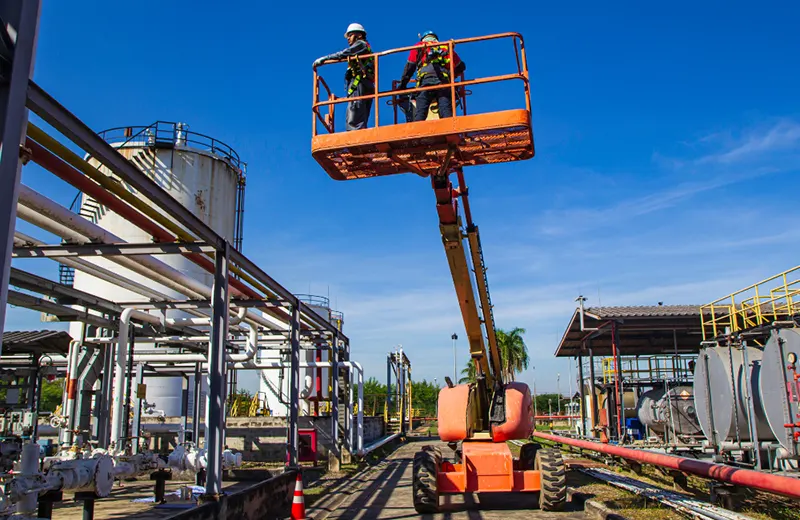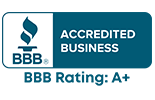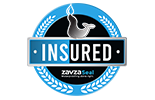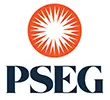If you’re looking into your options for support structures for heavy equipment, you’re in the right place. Support structures for heavy equipment keep things like turbines, pumps, conveyors, and electrical gear in place — and in some cases, above flood or storm surge levels. In factories, commercial sites, and coastal areas, they use strong foundations like helical piers, micropiles, and sheet piles to spread weight into solid ground. Without the right support, heavy loads, water, or weak soil can lead to cracks, sinking, water damage, power outages, and even harm to nearby property or people during storms.
As certified installers of steel sheet piles, helical piers and anchors, and other advanced support systems, it’s our responsibility to ensure property owners get the right information to make smart, lasting decisions about their equipment support needs. In the sections ahead, we’ll cover how these systems work, why precision installation is critical to the protection of your property, and the benefits of choosing flood-resilient solutions for long-term performance. Secure your operations with the trusted expertise your project deserves—contact us today for advanced support systems that stand the test of time.
Protect Your Equipment, Property, And Peace Of Mind — Call Now For Proven, Flood-Resilient Support Systems!
Why Strong Support Structures Matter
When it comes to heavy machinery, a properly designed foundation is more than just a base. It’s the safeguard that keeps your investment running at peak performance for years. The benefits of equipment foundation solutions that meet engineering and regulatory standards extend far beyond simple load-bearing strength. With the right design and installation, your heavy machinery support systems can deliver:
- Stability Under Dynamic Loads: Prevents shifting during operation, protecting both equipment and workers.
- Reduction In Vibration Wear: Minimizes mechanical fatigue and extends component life.
- Prevention Of Settlement And Tilt: Keeps machinery level to avoid operational inefficiencies or safety hazards.
- Compliance With OSHA, NYC DOB, And Industry Codes: Ensures your site meets all legal and safety requirements.
- Resilience To Flood/Storm Surge Events: Keeps critical equipment protected and operational during extreme weather.
A properly engineered support system reduces downtime, improves safety, and safeguards against environmental and operational risks. If your project involves high-value equipment in NYC boroughs or Long Island, foundation safety isn’t optional — it’s essential.
Schedule Your Free Site Assessment Today and see how our certified team can design and install a support system tailored to your operational and environmental challenges.
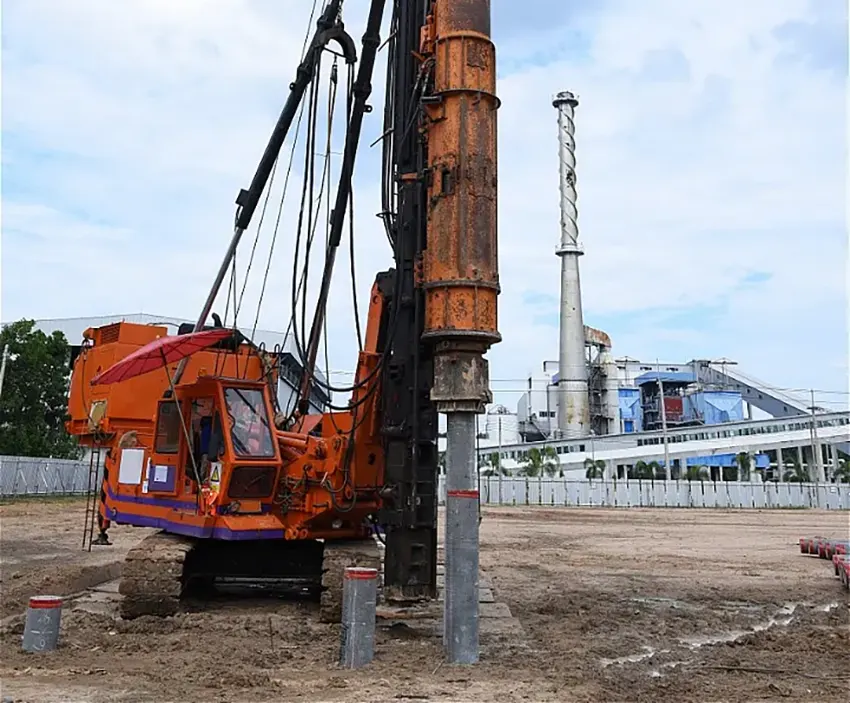
Conventional Foundation Support Options
When evaluating equipment support types, many projects begin by comparing concrete pad foundation vs piles and other familiar foundation support solutions. While these options can be effective in the right conditions, understanding their pros and cons is key to avoiding costly mistakes.
- Concrete Pads/Slabs: Affordable and widely available, concrete pads can be sized to spread equipment loads effectively. However, in high water table areas or flood zones, pads are prone to cracking and settlement, especially when the underlying soil becomes saturated.
- Steel I-Beam Platforms/Skids: A fast, portable solution for sites with stable soils. These frames can be prefabricated and set in place quickly. The drawback is that they still require solid ground or a stable base to perform well long term.
- Timber Cribbing/Blocking: Often used for temporary or emergency setups, timber cribbing is inexpensive and easy to work with. Unfortunately, it lacks durability, especially in wet or coastal environments, and should not be relied upon for permanent installations.
- Driven Piles/Micropiles: These systems reach deep into load-bearing strata, providing exceptional stability for heavy equipment. While highly effective, they can have longer installation times and higher upfront costs compared to shallow foundations.
We offer both conventional and advanced solutions so you get the right foundation for your specific operational and environmental challenges. Whether you’re installing equipment in an NYC factory, coastal facility, or industrial yard, our team ensures every foundation is engineered for long-term performance.
Advanced Support Systems: Helical Piers, Micropiles & Anchors
For projects in challenging conditions—such as poor soils, flood-prone zones, or confined urban sites—advanced systems like helical piers, micropiles, steel sheet piles, and helical anchors, offer unmatched performance.
- Helical Piers: Installed using torque-driven machinery, helical piers screw into stable soil layers for immediate load capacity. They’re ideal for poor or variable soils and can be installed year-round with minimal disturbance to the site.
- Micropiles: Designed for high-load applications in limited-access areas, micropiles are drilled deep into the ground and reinforced with steel. They’re perfect for retrofits, upgrades, or sites where vibration-sensitive operations rule out driven piles.
- Helical Anchors: Providing exceptional lateral and uplift resistance, helical anchors are especially valuable in flood or storm surge zones. They help keep equipment foundations in place even under extreme hydraulic and wind forces.
Benefits of Advanced Solutions:
- Minimal Disturbance, Fast Install
- High Load Capacity In Variable Soils
- Immediate Use After Install
- Easy Relocation Or Modification
- Corrosion-Resistant Coatings For Coastal Use
As a certified installer for all Earth Contact Products systems, we handle full design, supply, and installation in NYC’s toughest sites. From high-rise rooftops to waterfront industrial yards, our foundations are engineered to meet code, resist the elements, and support your most critical assets for decades.
Foundations That Don’t Flinch: Support Systems for Extreme NYC Weather
In flood-prone coastal NYC, an advanced flood resistant foundation NYC can mean the difference between uninterrupted operations and catastrophic equipment loss. Storm surge support foundation systems like helical piers, micropiles, and helical anchors outperform traditional pads and slabs when water levels rise and soils shift.
- Superior Scour Resistance: Deep embedment and engineered anchoring prevent undermining from fast-moving water.
- Maintains Stability During Soil Saturation/Erosion: Foundations transfer loads to deeper, undisturbed strata, keeping equipment secure even when top layers wash away.
- Allows Elevation Of Equipment Above FEMA Base Flood Elevation: Protects assets by raising them out of harm’s way during surge events.
- Integration With Steel Sheet Pile Walls For Perimeter Protection: Combines vertical and lateral defense for critical sites like pump stations, coastal factories, and aquariums.
- Rapid Emergency Installation: Advanced systems can be deployed quickly in advance of forecasted storms or as part of post-event recovery.
When every hour of downtime costs thousands in lost productivity or damaged goods, having a foundation system that stands up to extreme weather is an investment in security and continuity.
Contact us for a complimentary flood-risk consultation and discover how we can help you protect and elevate equipment above flood levels in NYC’s most vulnerable boroughs.
Design & Installation Process
We follow a proven, step-by-step method to ensure helical pier installation NYC, micropiles, and anchors meet both performance and regulatory requirements for your equipment foundation design.
- Site/Soil/Geotechnical Analysis: We assess soil composition, bearing capacity, and environmental factors.
- Load And Vibration Calculations: Ensure the foundation resists both static and operational loads.
- Pier/Anchor/Micropile Selection: Match the right system to site conditions and equipment needs.
- Layout And Torque Monitoring During Install: Maintain proper alignment and verify capacity in real-time.
- Equipment/Platform Attachment: Secure machinery to the foundation to prevent movement during operation or flooding.
- Integration With Drainage/Sheet Piling Where Needed: Combine systems for maximum protection in high-risk areas.
Tips For Optimal Performance:
- Use galvanization or epoxy coatings to protect steel in salt-air environments.
- Perform NYC code compliance checks before construction begins.
- Follow minimum embed depth standards for target load and soil type.
We manage every step in-house for speed, accuracy, and code compliance, ensuring your project runs efficiently from design through installation.
Cost, Timelines, And ROI For Equipment Foundation
Choosing the right equipment foundation is about more than upfront price. Factors like material type, installation speed, flood performance, and long-term resilience all play a role in the total return on investment. The table below compares common options so you can weigh cost against performance and operational impact.
| Foundation type | Install speed | Flood performance | Typical cost range |
|---|---|---|---|
| Helical piers | Hours | Excellent | Moderate |
| Micropiles | 1–2 days | Excellent | Higher |
| Concrete pads/slabs | Several days | Poor–Moderate | Lower |
Key takeaways:
- Time savings: Helical piers can be installed in hours compared to several days for concrete, reducing downtime.
- ROI advantage: A high-performing, flood-resistant foundation helps avoid costly equipment loss, keeps operations online, and allows for future scalability without full replacement.
- Long-term value: Over time, this translates into significant savings and greater operational resilience.
Ask us for a detailed ROI projection for your site to see how the right foundation can pay for itself in avoided repairs and downtime.
Support Structures for Heavy Equipment: Final Thoughts
Heavy equipment in NYC’s boroughs faces unique risks from soil conditions, vibration, and flooding. Advanced foundations like helical piers, micropiles, and anchors deliver the speed, stability, and resilience your operations demand. From Long Island’s coastal zones to Brooklyn’s industrial yards, we engineer each system to meet site conditions, code requirements, and your long-term goals.
Ready for a foundation that works as hard as your equipment? Call us today for expert installation in Long Island, Brooklyn, Queens, and The Bronx from your trusted helical pier contractor offering full floodproofing services and proven results as your support structures expert.
Frequently Asked Questions About Support Structures for Heavy Equipment
Can You Install In Sandy Soil Or High Groundwater?
Yes. Helical piers and micropiles penetrate through unstable surface layers and lock into deep, load-bearing strata.
Can Piers Be Removed Or Relocated?
Yes. Most pier systems are reusable and can be extracted or moved with minimal disruption to the site.
How Soon Can Equipment Be Set After Installation?
Immediately. Helical piers require no curing period, so equipment can be loaded the same day.
What Is The Lifespan And Maintenance Requirement?
Decades. With proper galvanization or epoxy coating, helical piers deliver long-term performance with little to no maintenance.
How Do You Prevent Helical Anchor Corrosion?
By using galvanized or epoxy-coated steel, which provides superior protection in coastal and flood-prone environments.
If you have any questions or would like to speak with an expert on the topic, contact Zavza Seal at (631) 980-1800.

